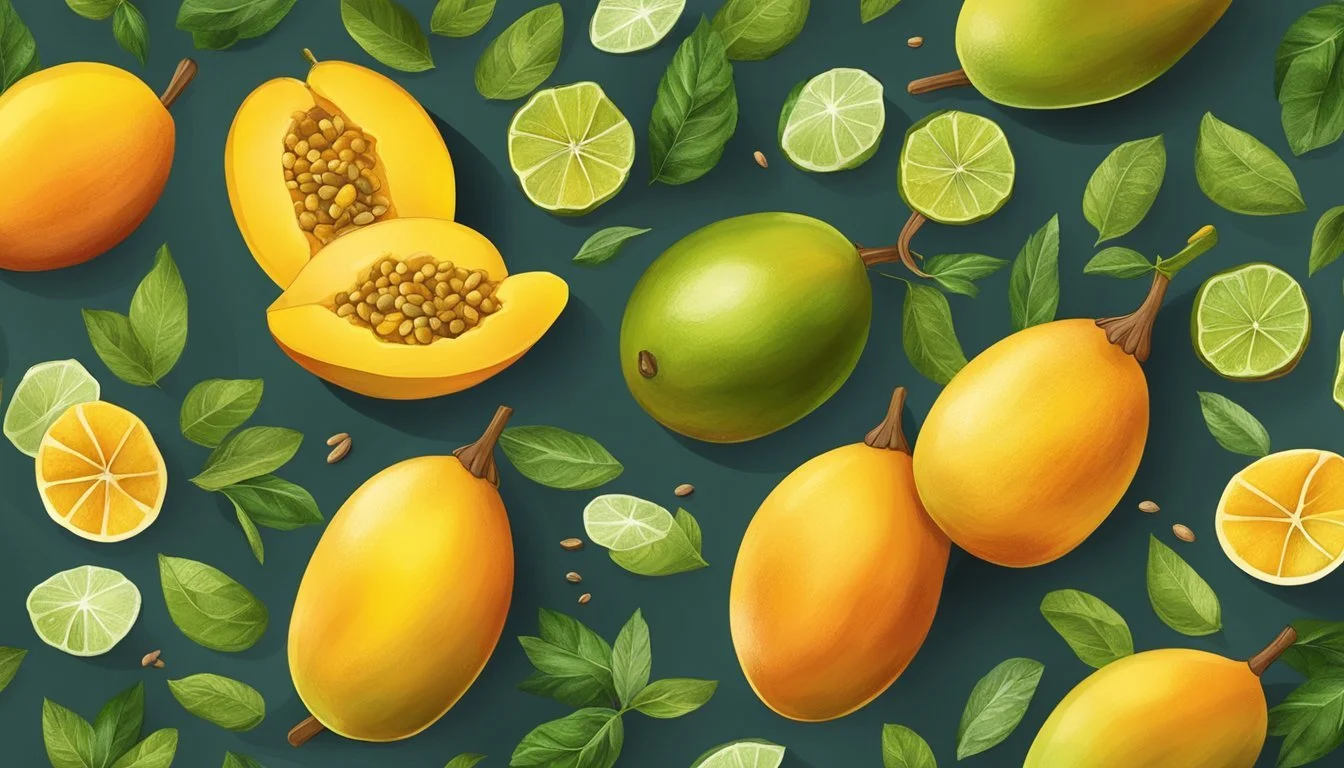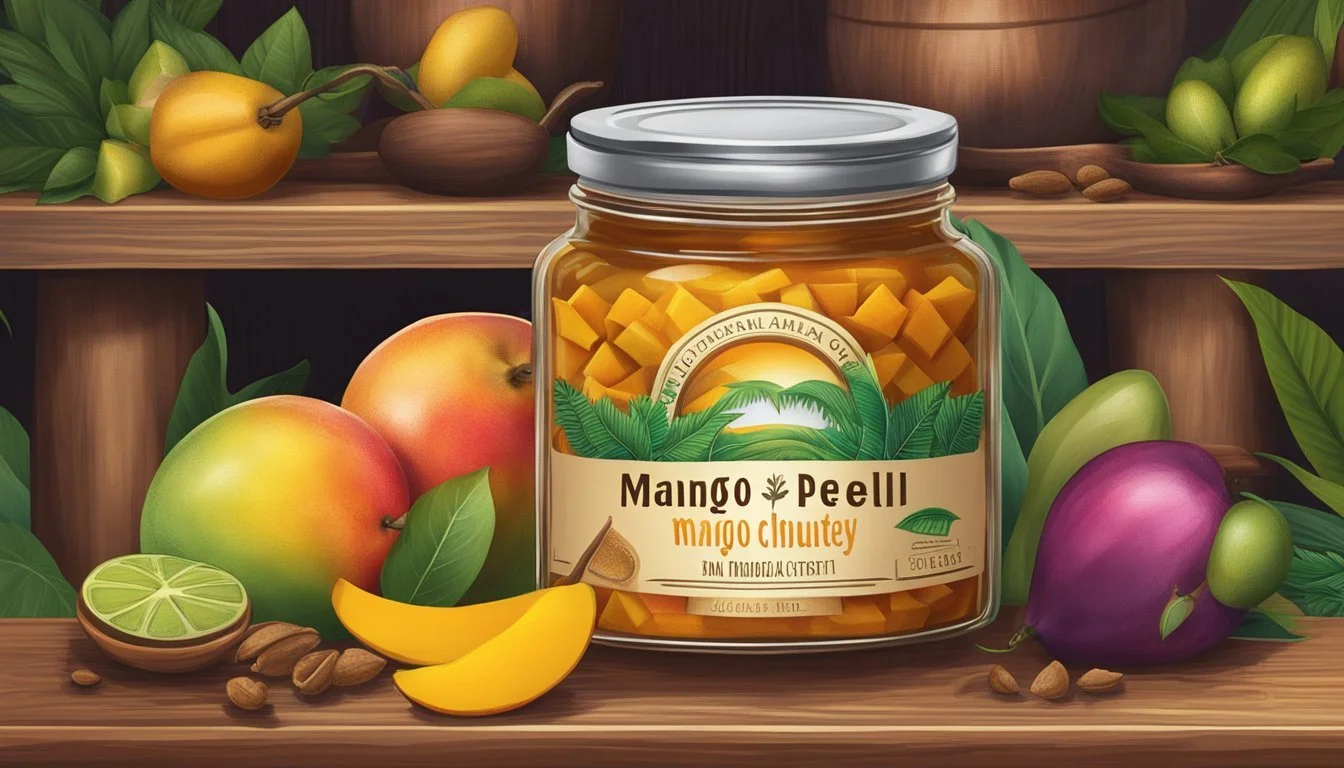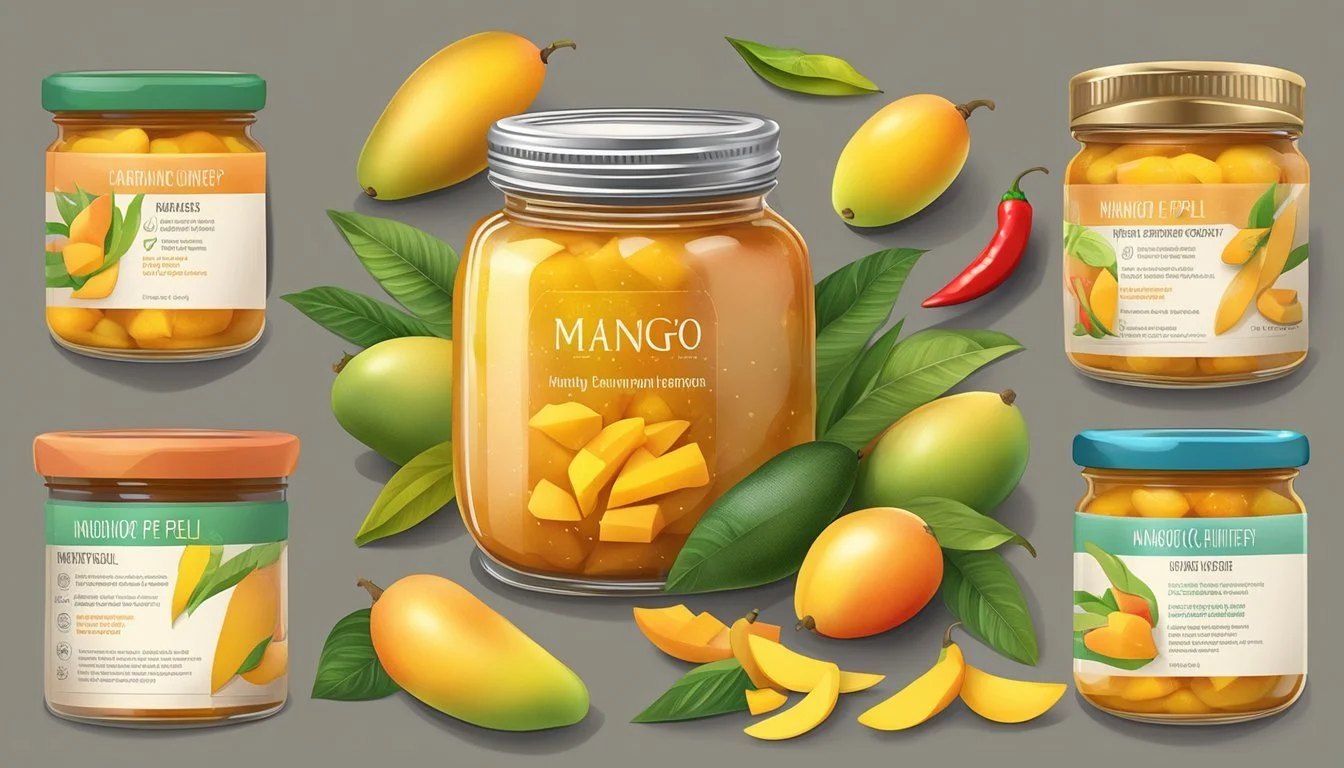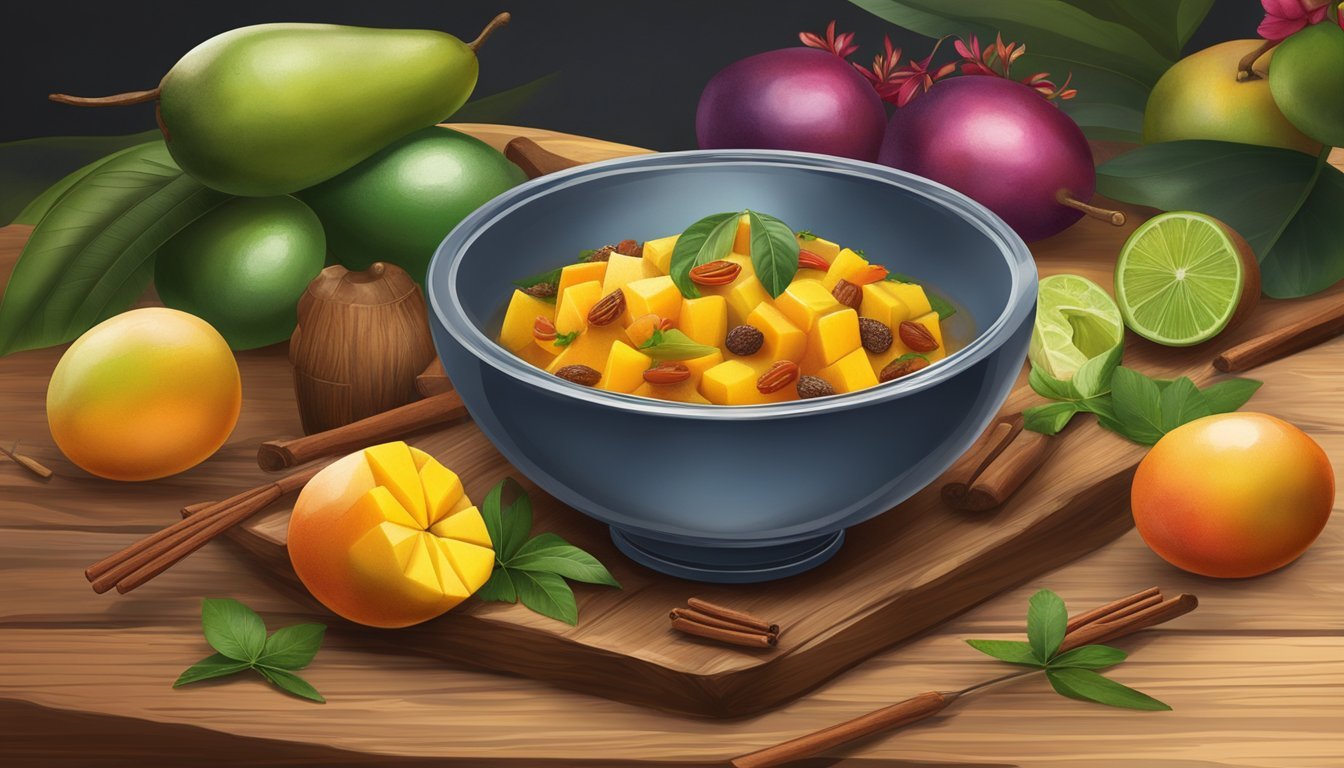Mango Peel Chutney
A Delightful Fusion of Tropical Flavors and Spices
Mango peel chutney harnesses the vibrant flavors of the tropics, transforming what would often be discarded into a spicy-sweet condiment that is both delicious and sustainable. With an emphasis on zero-waste cooking, this chutney utilizes mango peels, which are rich in fiber and antioxidants, to create a spread that is not only tasty but also environmentally conscious. The recipe combines the unique tang of mango with the warmth of spices, providing a robust complement to a variety of dishes.
The preparation of mango peel chutney involves simmering the peels with an array of spices such as black mustard seeds, curry leaves, and ginger, resulting in a thick, paste-like consistency. Often tempered with neutral oil, these spices release their flavors to form a complex, layered taste experience. The chutney can be enjoyed in several ways: as an accompaniment to curries, as a spread on sandwiches, or even as a unique pairing with cheese and crackers, showcasing its versatility in both sweet and savory contexts.
In a time when sustainable practices are of utmost importance, making mango peel chutney is a flavorful way to engage in kitchen resourcefulness. It stands as a testament to the creativity of global cuisines and the ongoing efforts to minimize food waste, inviting home cooks to explore new flavors while contributing to a more sustainable culinary future.
The Origin and Popularity of Mango Chutney
Mango Chutney has its roots deeply embedded in Indian culture and has grown to become a beloved condiment worldwide due to its versatility and unique taste.
Cultural Significance in Indian Cuisine
Originating in India, mango chutney is a traditional condiment made from ripe or unripe mangoes, sugar, vinegar, and a variety of spices. In India, it's a staple that transcends regional boundaries, where it is revered not just for its sweet and spicy flavor profile but also for its digestive properties. Often served with curries, the chutney complements rich, spicy dishes (What wine goes well with spicy dishes?) by adding a refreshing burst of sweetness. Additionally, it is commonly used alongside bread such as naan or paratha, turning simple meals into flavorful feasts.
Global Adoption and Variations
As British colonization introduced Indian cuisine to the West, mango chutney quickly became popular in European countries and subsequently around the globe. Diverse in its use, mango chutney has found its place in various global cuisines. In sandwiches, it adds a tropical, tangy twist, while in regions like South Africa and the Caribbean, local ingredients have been incorporated to create unique regional variations. As a result, the basic premise of mango chutney has been adapted numerous times, resulting in a condiment that's appreciated in myriad forms across the world.
Selecting Ingredients for Mango Peel Chutney
In crafting the perfect Mango Peel Chutney, selecting top-quality ingredients is paramount. This section provides guidance on choosing the right mangoes and complementary fruits and vegetables to ensure a flavorful outcome.
Choosing the Right Mangoes
The star ingredient of Mango Peel Chutney is, indisputably, the mango. For the chutney, ripe mangoes are essential as they provide the ideal sweetness and texture. The peels of ripe mangoes should be intact and free from blemishes, as they will be used in the recipe. It's advisable to procure mangoes during the mango season, which varies depending on the region, to ensure freshness and flavor. The objective is to obtain fresh mangoes that are neither overly ripe nor unripe.
Complementary Fruits and Vegetables
Beyond mangoes, an assortment of vegetables enhances the chutney's complexity:
Red Onion: thinly sliced for a balance of sweetness and sharpness.
Bell Pepper: diced, with color options such as red or green to add vibrancy and a subtle bitter-sweet note.
Ginger: freshly grated, offering a warm, zesty kick to the chutney.
Garlic: finely minced, contributing rich, aromatic undertones.
Spices such as chilli powder, turmeric, and cumin should be freshly ground, if possible, for maximum potency. Apple cider vinegar provides an essential tangy accent, keeping the flavor profile balanced and bright. Selecting the right combination of these ingredients will elevate the overall taste and aroma of the Mango Peel Chutney.
Essential Spices and Sweeteners
The creation of Mango Peel Chutney hinges on a delicate balance of spices and sweeteners, each contributing to the final flavor profile. This section delves into the interplay of sweet and spicy elements, as well as alternative sweeteners that can be used to customize the chutney to taste.
Balancing Sweetness and Spice
Mango Peel Chutney is characterized by the fusion of sweet and spicy flavors. Sweetness is typically introduced through sugar which can be adjusted according to taste. Common choices include:
White sugar: A standard sweetener that dissolves easily.
Brown sugar: Adds a deeper molasses flavor.
Honey: An alternative for a smoother, natural sweetness.
On the other hand, the spice element comes from a blend of aromatic spices, crucial for depth and complexity. Key spices include:
Ginger: Provides a pungent, warm spice.
Garlic: Offers a savory background note.
Mustard seeds: Impart a slight heat and nuttiness, often tempered in oil for chutney.
Cinnamon & Cloves: Add warming, earthy tones.
Vinegar is often employed to cut through the sweetness with its tangy profile, with options like:
Cider vinegar: For a fruity acidity.
Distilled white vinegar: For a clean, sharp tartness.
A pinch of salt is essential to enhance all the flavors, making them more pronounced.
Alternative Sweetening Options
For those seeking substitutes for traditional sweeteners, various alternatives can be considered to tailor the chutney to dietary restrictions or flavor preferences. Among these are:
Maple syrup: Provides a unique, woodsy sweetness.
Coconut sugar: Offers a lower glycemic index with a caramel-like taste.
Light brown sugar: Delivers a more delicate molasses essence than its darker counterpart.
Each alternative not only alters the chutney's sweetness but can also introduce new, subtle flavor notes and adjust its overall texture. It's important to experiment with proportions, as these sweeteners vary in sweetness intensity and may interact differently with the chutney's acidic components.
Chutney Preparation Techniques
Creating mango peel chutney involves specific techniques to ensure a balance of tropical flavors and a pleasing texture. The preparation includes peeling and cutting mangoes, a careful cooking process, and blending to the right consistency.
Peeling and Cutting Mangos
To begin, one must carefully peel the mangoes, ensuring minimal wastage of the flesh. The peels are then set aside, as they will be the primary ingredient in this chutney. Next, the flesh is cut into small cubes if it's to be included in the chutney for added texture and sweetness. It's crucial to cut uniformly to ensure even cooking.
Tools: Knife, Vegetable Peeler
Technique: Peel skins, cube flesh evenly
Cooking and Simmering
In a medium saucepan, heat an appropriate oil such as neutral oil or perhaps olive oil for a fruity twist, and begin by sautéing aromatic elements like ginger and garlic. Once these ingredients release their fragrance, the mango peels, additional spices, and a citrus element (like lemon or lime juice) are added. The mixture is then brought to a simmer, often with a pinch of cornstarch for thickening. This process may take 10 to 30 minutes.
Ingredients: Mango peels, garlic, ginger, oil, citrus juice, cornstarch
Process: Sauté, add ingredients, simmer until thickened
Blending for Consistency
After the ingredients are softened and the flavors melded, use a blender or food processor to create a smooth sauce. Some recipes might call for leaving the chutney chunky, while others prefer a fine puree. Adjust the blending time to achieve the desired consistency.
Tools: Blender, Food Processor
Method: Puree until smooth or desired texture is reached
Serving and Pairing Suggestions
The versatility of Mango Peel Chutney makes it ideal for enhancing the flavor of various dishes. Its sweet and spicy profile allows it to pair well with an array of foods, from snacks to main courses.
Using Mango Peel Chutney as a Dip
Mango Peel Chutney serves as an excellent dip for a variety of appetizers.
For Cheese: Pair it with mild cheeses like goat cheese or cream cheese to balance the sweetness with a creamy texture.
Spring Rolls and Appetizers: It adds a tropical twist to vegetable or pork spring rolls.
Chips and Crackers: Use it as a dip for tortilla chips or savory crackers for a quick snack.
Incorporating into Meals
Mango Peel Chutney enhances main courses and sides:
Curries: It contributes a sweet and spicy element when served alongside curry dishes.
Rice Dishes: Incorporate it into rice preparations to add a subtle, fruity flavor.
Grilled Meats: Brush onto grilled chicken or fish as a glaze.
Salads: Mix into dressings or top salads to add a burst of flavor.
Breads: Spread on flatbreads such as paratha or naan as a flavorful condiment.
Preservation and Storage Tips
Proper preservation is crucial for extending the shelf life of mango peel chutney. Using the right techniques can ensure that the chutney retains its flavor and is safe for consumption.
Refrigeration and Shelf Life
Mango peel chutney should be stored in the refrigerator to maintain its freshness. Upon completion, it must be placed in an airtight container to prevent contamination and flavor loss. The acidity from vinegar acts as a natural preservative. Whether one uses cider vinegar, rice vinegar, or white vinegar, it’s essential that there is enough acidity in the chutney to inhibit bacterial growth. The presence of salt also aids in preservation. When refrigerated properly, the chutney can last for about 1-2 weeks.
Proper Container: Airtight glass jar
Temperature: Keep refrigerated at or below 40°F (4°C)
Shelf Life: 1-2 weeks
Freezing and Thawing Procedures
For long-term storage, mango peel chutney can be kept in the freezer. To prevent freezer burn, it should be stored in heavy-duty freezer bags or airtight containers made for freezing. Each container or bag ought to be labeled with the date to track how long it's been stored. In the freezer, the mango peel chutney has a shelf life of up to 6 months. Thawing should be done in the refrigerator, and once thawed, it’s not recommended to refreeze.
Proper Container: Freezer bags or airtight containers suitable for freezing
Freezer Shelf Life: Up to 6 months
Thawing: Thaw in the refrigerator
Remember to leave room for expansion when freezing the chutney, and always thaw it in the refrigerator to maintain safety and quality.
Nutritional Information and Health Benefits
Mango peel chutney marries the spicy essence of traditional chutneys with the rich nutritional profile of mangoes. This section will explore its dietary fibers and essential nutrients alongside dietary implications.
Digestive Health and Nutrient Content
Mango peel is a source of dietary fiber that supports digestive health. The chutney made from this ingredient includes a combination of fibrous fruit peel which can facilitate bowel regularity and may contribute to a healthy gut microbiome.
Fiber Content: Aids in preventing constipation and promotes satiety.
Additionally, this chutney is packed with nutrients such as vitamin C and vitamin A, both of which are essential for immune function and skin health, respectively.
Vitamin C: An antioxidant that supports the immune system.
Vitamin A: Important for maintaining healthy vision and skin.
Dietary Considerations
Mango peel chutney can be a healthy addition to a vegan or gluten-free diet. As it contains no animal products and no gluten-containing ingredients, it accommodates those with specific dietary restrictions.
Vegan: Contains no animal products.
Gluten-Free: Does not include ingredients with gluten.
The chutney is also characterized by its incorporation of whole fruits and vegetables, enhancing its nutrient density and making it a wholesome choice for those looking to incorporate more plant-based foods into their diets.
Customizing Your Mango Peel Chutney
Crafting the perfect mango peel chutney allows one to balance flavors to personal taste. Individuals can adjust the levels of sweetness and heat or introduce a variety of creative add-ins and variations to develop unique flavors.
Adjusting Sweetness and Heat
Spice Level: This can be easily tailored by altering the number and type of chilis used. For a milder chutney, one may opt for a smaller quantity of chili powder or eliminate it entirely. Those desiring a fiery profile might include habanero peppers, known for their intense heat.
Sweetness: The natural sweetness of mango peels is often amplified by additional sugar, but one can also seek alternatives like honey for a different flavor profile. The type and amount of sweetener can directly influence the balance between sweet and spicy elements, resulting in a harmonious sauce.
Creative Add-Ins and Variations
Spices and Herbs:
Mustard Seeds: Often used for tempering, they add a pungent kick.
Garam Masala: A blend that introduces complex warmth and depth.
Coriander: Lends a lemony, floral note that complements the mango.
Sauces:
Sweet and Spicy Sauce: Incorporation can intensify both sweet and heat aspects.
Mango Hot Sauce: Merges seamlessly for an extra fruit-forward heat.
List of Optional Ingredients for Variation:
Fruits: Addition of diced apples or citrus zest for tanginess.
Nuts and Seeds: Crushed almonds or sesame seeds for texture.
Herbs: Chopped mint or cilantro for a fresh twist.
The chutney's versatility allows it to evolve from a traditional spread to a personalized condiment, which one can adjust and modify while remaining true to its origin. The selection of spices, level of sweetness, and heat are all modifiable, and the introduction of new ingredients can transform the chutney into a signature addition to any culinary repertoire.
Troubleshooting Common Issues
In the process of making Mango Peel Chutney, cooks may encounter issues such as the spread sticking to the cooking vessel or not reaching the desired consistency. The following tips can help overcome these challenges, ensuring a smooth cooking experience and a deliciously balanced sweet and spicy spread.
Preventing Chutney from Sticking
To avoid chutney from sticking to the pan, consistent stirring is key. Cooks should use a heavy-bottomed pan and stir the mixture frequently. Moderate heat should be maintained as high heat may cause sticking and burning. If the chutney starts to stick, adding a small amount of water can help, but do so sparingly to avoid diluting the flavors.
Achieving Desired Thickness
For a thicker consistency, allowing the chutney to simmer uncovered will enable moisture to evaporate. If the chutney remains too thin, a slurry of cornstarch and water may be added. Start with:
1 tablespoon of cornstarch
2 tablespoons of water
Mix them together and then stir into the chutney. It's important to cook for a few minutes after adding the cornstarch to remove any starchy flavor. Conversely, if the chutney is too thick, a little water can be added to lighten it. The cook should aim for a balance where the chutney is neither too runny nor too dense, capturing the perfect sweet and spicy profile.
Conclusion
Mango peel chutney is a testament to an innovative and sustainable approach to cooking. By reusing what would otherwise be discarded, it offers a flavorful and eco-friendly solution. Whether served with a hearty meal or used to enhance a snack, its spicy-sweet taste is versatile enough to complement various dishes. The combination of ingredients like garlic, ginger, and spices stems from a deep-rooted tradition in Indian cuisine yet can be tailored to suit palates across the globe.
The process for creating mango peel chutney may include:
Blending the mango peels with a combination of herbs and spices until smooth.
Heating oil and tempering mustard seeds and curry leaves to infuse the oil with flavor.
Combining the tempered spices with the blended mixture to marry the flavors.
Mango peels, rich in nutrients and flavor, prove valuable in this zero-waste chutney. It not only reduces food waste but also provides a nutrient boost. The end result is a spread that pairs wonderfully with a variety of foods including breads, rice, and meats.
Cooking enthusiasts are encouraged to explore and experiment with mango peel chutney, using it as a base to create unique variations that cater to individual taste preferences. Cooks can take pride in preparing a chutney that is not only delicious but promotes sustainability.







